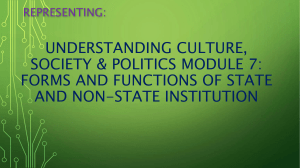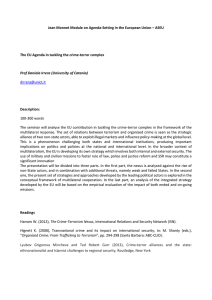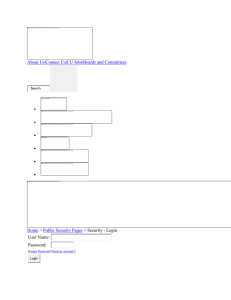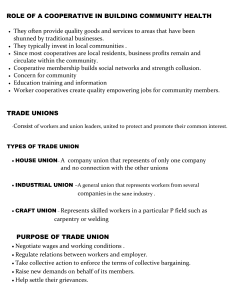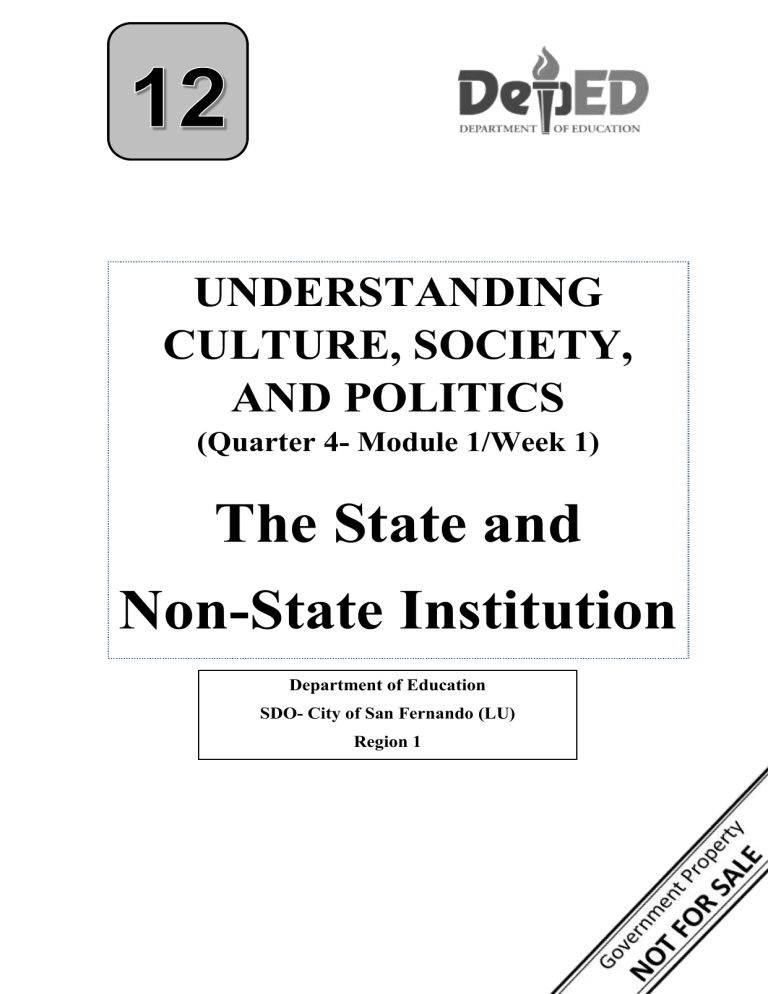
UNDERSTANDING CULTURE, SOCIETY, AND POLITICS (Quarter 4- Module 1/Week 1) The State and Non-State Institution Department of Education SDO- City of San Fernando (LU) Region 1 12 UNDERSTANDING CULTURE, SOCIETY, AND POLITICS (Quarter 4- Module 1/Week 1) THE STATE and NON-STATE INSTITUTION MOST ESSENTIAL LEARNING COMPETENCIES Explain the forms and functions of state and non-state institution 2 Our Guide For the parents: 1. Please guide your child while he is studying and answering the tasks provided in this module. 2. Remind your child about his study time and schedule so he can finish the module. 3. Let your child answer the module activities independently, however, assist him only when necessary. 4. I will call on a certain time based on the schedule to explain the lessons in the module. 5. Kindly return the whole module and answer sheets on _________ during Fridays at ____________________. For the learners: 1. Carefully read the directions so that you will know what to do. 2. If there are directions or topics in the module that are difficult for you to understand, feel free to ask from your parents or companions at home. However, if you still could not understand, you can call me at this number, _____________so I could explain it to you clearly. 3. Answer the activities in the module on the specific day for the subject. Use a separate sheet of paper for your answers. Avoid writing or tearing the pages of this module because this will be used by other pupils/students like you. 4. Write important concepts in your notebook regarding your lesson. This will help you in your review later. 5. You need to finish the activities in this module so that you can give this to your parents on ___________________________. Always remember these health tips: 1. 2. 3. 4. Remember to wear your face mask properly and regularly. Always wash your hands with clean water and soap. Cover your mouth and nose with handkerchief whenever you cough or sneeze. Follow the one-meter distance so that you will prevent the spread of the virus. 3 This module has the following parts and corresponding icons: What I Need to Know This will give you an idea of the skills or competencies you are expected to learn in the module. What I know This part includes an activity that aims to check what you already know about the lesson to take. If you get all the answers correct (100%), you may decide to skip this module. What’s In This is a brief drill or review to help you link the current lesson with the previous one. What’s New In this portion, the new lesson will be introduced to you in various ways; a story, a song, a poem, a problem opener, an activity or a situation. What is it This section provides a brief discussion of the lesson. This aims to help you discover and understand new concepts and skills. What’s More This comprises activities for independent practice to solidify your understanding and skills of the topic. You may check the answers to the exercises using the Answer Key at the end of the module. This includes questions or blank sentence/paragraph to be filled in to process what you learned from the lesson. What I have Learned What I can do This section provides an activity which will help you transfer your new knowledge or skill into real life situations or concerns. Assessment This is a task which aims to evaluate your level of mastery in achieving the learning competency. Additional Activities In this portion, another activity will be given to you to enrich your knowledge or skill of the lesson learned. 4 LESSON THE STATE and NON-STATE INSTITUTION 1 What I Need to Know You have learned a lot from your previous module. I believe that it is time for you to level up your knowledge. In this module you will be able to learn and understand the different forms and functions of state and non-state institution. What I Know Pre-Assessment Direction: Write TRUE if the statement is correct and FALSE if it is incorrect. _____1. Institution is composed of a set of formal rules and informal norms. _____2. Transnational advocacy network includes actors working together nationally. _____3. There can be no state without territory. _____4. State institutions are institutions that have state functions and are established to support the government. _____5. Internal sovereign is independent and free from outside control. 5 What’s In Before we move on to the next lesson let us first turn back the hands of time and see if you still remember what was discussed in the previous module. Direction: Read the statement carefully and choose the letter that corresponds to the correct answer. _____1. These are groups which are organized to meet the special interest of the members. A. Influence groups B. In-groups C. Special interest groups D. Task groups _____2. The goal of these groups are clearly stated. A. Formal groups B. In-groups C. Out groups D. Relationship groups _____3. It is a social unit in which the individual feel at home. A. Formal group B. In group C. Primary group D. Psychological group _____4. A collection of people where members interact on a regular basis. A. Formal group B. primary group C. Secondary group D. Social group _____5. These are group that are organized to fulfill the feeling of companionship. A. Formal groups B. Informal groups 6 C. Relationship groups D. Task group What’s New You often hear the word ‘state.’ But do you really understand what it is? Is it simply a place that we live in? or, have you come across with the term ‘non-state’? Most of us are not really familiar with these terms or we are not really aware about them. However, it is important for us to understand these since we are a part of it. Furthermore, there are state and non-state institutions whose functions may benefit every individual being a part of the state. What is It What is a State? It is a community of persons, more or less numerous, occupying a definite portion of the earth’s surface, having its own government, through which the inhabitants render habitual obedience free from outside control. Four Elements of State 1. People/ population– It is important that the community of persons is composed of both females and males for purpose of reproduction. Reproduction is indispensable. It is through reproduction that the state can continue to exist. However, there is no requirement as to the number of people living in a territory for it to be classified as state. 2. Territory – There can be no state without territory. People need territory to live and organized themselves socially and politically. It may be remembered that the territory of the state includes land, water and air/space. Within it are natural resources which are vital for people to live and they have the responsibility to protect and conserve it. 7 Furthermore, the people must be able to defend their state from invaders, and in doing so, the use of force may be justified. 3. Government – This is the vital ingredient of the state. There can be no state without government. The government is the working agency of the state. It is the political organization of the state. This is where the laws to be implemented in the country are enacted. Since it is believed that the government should be established by the people themselves, through the constitution that they will promulgate, it is but logical for them to bestow their obedience to it. The people should follow the laws and respect the authority. 4. Sovereignty – It refers to the supreme power of the state to rule itself without interference from other states. This means that the state is an independent entity where people enjoy freedom. A territory is not a state if it is not independent. Two aspects of Sovereignty Internal Sovereign – The state is supreme over all its citizens, and associations. External Sovereignty – The state is independent and free from foreign or outside control. What is institution? Composed of a set of formal rules, informal norms, or agreed upon understanding that constraints or prescribed political actor’s behaviour and interaction with one another. Main Function: Keep society in order and implement specific tasks assigned to them. State Institutions Institutions that have state functions and are established to govern the state. 3 Branches of the Government 1. Executive 2. Legislative 3. Judiciary Non-State Institution 8 Non-state are a group of people or an organizations and individuals that are not affiliated with, directed by, or funded through the government. However, some of the non-state institutions are also major players in state or market-related activities. Some of them operate globally, while some operate at the global level. A. Banks and Corporations Banks – a financial institution licensed to provide several financial services to different types of customers - There are many role of the bank but the most basic role it has is the regulation of the society’s flow of money Corporations – known as body of people acting as a single entity. - It is created by a group of shareholders who have ownership of the corporation. - Corporation usually set up to create profit and to provide return for its shareholders B. Cooperatives and Trade Unions Cooperatives – association of persons united to meet their common economic, social and cultural needs through a jointly owned and democratically controlled enterprise. - Cooperatives exist among different industries and are composed of different types of people, it may be farmers, consumers, or workers. Trade Unions – were organized by workers to share in a mutual benefit between members. - It is also called labor unions. - These are organizations composed of workers and laborers or employees from related fields, which aims to represent the interest and rights of its members, both in the workplace and in the society. C. Transnational advocacy Groups ADVOCACY is an idea from an individual or group which aims to influence a political, economic and social decision. - Transnational advocacy network includes actors working together internationally on an issue. 9 Advocacy groups - spread information in support of a cause across borders in attempt to change international policies and practices. D. Development Agencies - Economic development agencies are described to be independent organizations that aim to implement strategic ways of developing territories and societies. - Usually molded by public and private institutions. - Development agencies are organizations that simply wish to improve the current standpoint of a certain society. E. International Organizations - Refers to institutions established by three or more states as voluntary members in order to promote cooperation and coordination among them What Have I Learned? You have learned what a state is and its four elements which are the people/population, territory, Government, and sovereignty. Within a state are institutions. Institutions keep society in order and implement specific tasks assigned to them. State institutions have state functions and is established to govern the state. On the other hand, nonstate institutions are people or organizations that participate in international affairs and relations but are not affiliated with any state or nation. 10 What I can do Direction: Write an essay on the implications of the presence of the non-state institutions in our country. What benefits do we get from them as individual? What are the adverse issues that arise from their presence? Your essay will be rated according to the rubrics below: Features 4 3 Quality of Essay was very Essay writing informative and somewhat well-organized 2 1 was Essay gives Essay gives no some new informative and information but information and organized in poorly very organized poorly organized manner Grammar usage No and mechanics Clarity of spelling, Few spelling, A number of So punctuation, or punctuation or spelling, many spelling, grammatical grammatical punctuation or punctuation, or error error grammatical grammatical error is present error Acceptable Vague Very clear Clear discussion 11 Assessment Direction: Choose the letter of the correct answer. Write your answer on the space provided before the number. _____1. They are institutions that have the state functions and are established to govern the state. A. Bank C. Non-state institutions B. International Organizations D. State institutions _____2. It aims to influence a political, economic and social decision. A. Advocacy C. International Sovereign B. Development Agencies D. Legislative _____3. It exist among different industries and are composed of different types of people. A. Advocacy C. Corporation B. Cooperative D. Union _____4. It is a community of persons, more or less numerous having its own government. A. Corporations C. Judiciary B. Government D. State _____5. It is a financial institution licensed to provide several financial services to different types of customers. A. Advocacy C. Development Agencies B. Bank D. Trade Unions 12 _____6. It refers to institutions established by three or more states as voluntary members. A. Advocacy Groups C. Cooperative B. International Organization D. Corporation _____7. It is usually molded by public and private institutions. A. Cooperatives C. International Organizations B. Development Agencies D. Development Agencies _____8. It is also known as labor union. A. Cooperatives C. non-state institutions B. Judiciary D. Trade Unions _____9. It is usually set up to create profit and provide return for its shareholders. A. Advocacy Groups C. Corporations B. Cooperatives D. Trade Unions _____10. These are groups of people or an organizations and individuals that are not affiliated with the government. A. Bank C. Non-state institutions B. Institution D. State 13 References Printed Resources Contreras et al. (2016) Understanding Culture, Society and Politics Aguilar et al. (2016) Understanding Society, Culture, and Politics for Senior High School Electronic Resources https://www.google.com/search?q=explain+the+elements+of+a+state&tbm=isch&source=iu &ictx=1&fir=2LDbVKFbkjYxiM%252CGFJB6NbMTLzCyM%252C_&vet=1&usg=AI4_kRmSrknyDhOPcJ7lD6Y7bG4LwZhQ&sa=X&ved=2ahUKEwi37eLz1InwAhUMc5QKHeoMCLQQ_h16BAgKEAE #imgrc=m8_HTBcJpGDu6M https://www.britannica.com/search?query=Institution https://www.youtube.com/watch?v=xEhHDKN4o6A 14 Development Team of the Module Sherryl V. Soriano, Teacher II Writer/Illustrator/Layout Artist: Bernardo T. Rombawa- EPS in charge Editor/Evaluator/Reviewer: Brenda A. Sabado, Principal IV – LUNHS Thea Zonette S. Medrano, OIC-Assistant Principal Management Team: Dr. Rowena C. Banzon, CESO V, SDS Dr. Wilfredo E. Sindayen, ASDS Dr. Agnes B. Cacap, Chief- CID Dr. Jose Mari P. Almeida, Chief- SGOD Genevieve B. Ugay, EPS- LRMS Hazel B. Libatique, Librarian II Aurelio C. Dayag, Jr., PDO II 15 Key Answer Pre-Assessment 1. True 2. False 3. True 4. False 5. False What’s In 1. C 2. A 3. B 4. D 5. C Assessment 1. D 2. A 3. B 4. D 5. B 6. B 7. B 8. D 9. C 10. C 16
